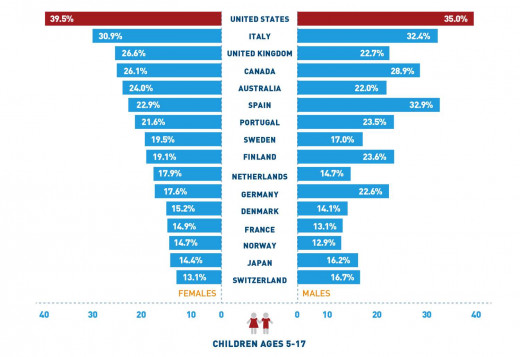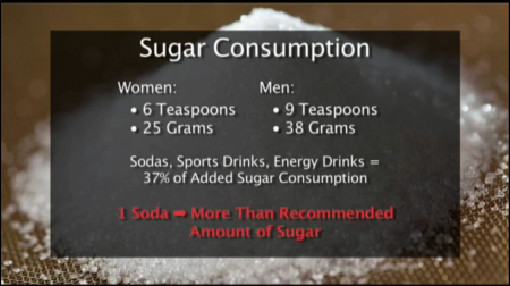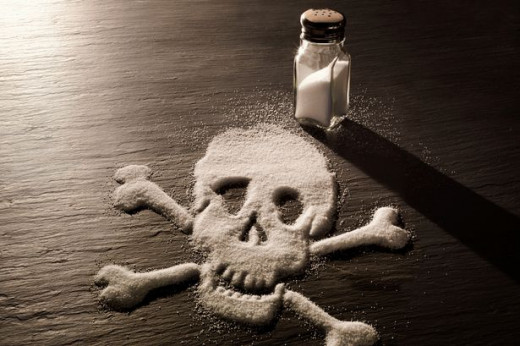Epidemic of Unhealthy Foods

Introduction
Obesity has reached critical limits, especially in the United States. No matter how hard Michelle Obama may try, obesity remains a devastating problem for the nation. It is not because United States citizens are lazy; the problem lies in the food industry. The FDA will not regulate junk foods because the choice lies in the people due to the fact that, in the United States, individual rights and freedoms are taken very seriously. We should have the right to be able to choose what we eat; however, when we pick the foods off of the shelves in the grocery store, we hardly ever peer at the nutrition label. If we did look at the nutrition facts and had a decent understanding of them, then we would surely be horrified by what we put into our bodies. How could something so devastating to our health, such as doughnuts, taste so good?
Evolutionary Perspective
Sugars and salts are the key components to any delicious meal. These are the main ingredients for McDonald’s food, junk food, and desserts. We love these foods because our bodies are hardwired to experience joy when we eat sugar and salt. This is because sugar and salt signify foods that are energy-rich. Thousands of years ago, sugars and salts would be very beneficial to human survival (Breslin 2013). These days, when we have an overabundance of such foods, it makes sense that we would eat them in preference to low-energy foods (vegetables). Food distributors know this; of course, they also know that we are knowledgeable of the harm of too much sugar and salt. As a result, many food items in the store are laden with healthy connotations on the labels. A simple glass of store-bought orange juice is almost enough to meet your daily sugar limit. That is why we need to know the details of how much sugar and salt we can have a day and read the nutrition labels of foods to compare.

Sugars
It is gross how much sugar we eat as a people. On average, the USA citizen eats about 150 grams of sugar (Forbes 2012). Seeing as how women are supposed to eat a max of 25 grams and men are supposed to eat only 38 grams, we have a serious problem in this nation. We cannot go on eating 5-7 times the suggested amount of sugar without serious health problems. A variety of diseases come with the overconsumption of sugar. Is it really worth it to risk cancer or heart problems in order to eat as much sugar as we please? Even if we avoid desserts or junk food, sugar is so widespread in the food products we eat that we would still surely surpass the daily limit of sugar intake.

Salts
The average meal out at a restaurant or fast food joint would most likely meet or exceed your daily salt limit. Recently, the American Heart Association changed the recommended maximum salt intake to 1,500 mg a day. If we were to follow this limit as a nation, we could save a total of $26 billion and as much as a million lives (American Heart Association 2014). The main health risk associated with too much salt intake is high blood pressure. Those who suffer from high blood pressure are much more likely to fall victim to heart failure (the number one killer in the United States). Salt is a deadly ingredient that is often seen as necessary for the variety of meals families cook. But, this taste enhancer will not be worth it for you in the future. We love you salt; but, you are breaking our hearts.
Suffering of the Poor
Unhealthy foods are so commonplace and cheap that it makes almost no sense to spend the extra money and time on finding and buying healthy foods that tend not to taste as good. Indeed, healthy foods cost an average of $550 extra a year (Huffington Post 2013). Why would we go to Trader Joes or Whole Foods when we have the much cheaper and closer Wal-Mart? We are not all well-to-do and must cut corners every now and then. However, the intake of unhealthy foods on a daily basis, as previously discussed, leaks into extra healthcare costs and thus becomes disastrous for the body as well as the wallet. If you do not want to spend the extra money on a healthy diet, simply think of it as a sort of insurance for yourself. A healthier diet will save your bank account in the long-run.
Solutions
It is our duty as citizens to help improve the health of our nation. As anyone can tell, people generally choose not to eat healthy. As a result, legislators have banned certain unhealthy food items. For example, Mayor Bloomberg of New York City proposed a limit on sodas larger than 16 oz. Consequently, the vast majority of New Yorkers were vehemently opposed to such a blatant attack on the freedom of choice. The final court of appeals decided against the soda ban ultimately in June of 2014 (New York Times 2014). In other words, the soda ban was rejected on all fronts in New York. Thus, banning certain food items seems not the way to go about changing the health of society for the better. Global outrage is likely to counter any food ban, as so happened with the soda ban; therefore, it would be much better to seek a tactic that pushes people to eat healthier, without taking away their rights.
The best course of action would be to “nudge” people towards a healthy life. In the book “Nudge: Improving Decisions About Health, Wealth, and Happiness” by Thaler and Sunstein, there is a call to change behavior through simply offering incentives for people to do the right thing. To put it another way, instead of banning soda, it would be better to make larger sodas much more expensive than smaller ones. A major problem in the soda industry is that the 52 oz. soda is only a few cents more than the 16 oz. one. As a result, when customers buy a soda, they are much more likely to go for the larger one because they see that is saves them money. If the government were to choose a tactic that nudges, rather than stick to the usual authoritarian routine, then people would still remain just as free but would be nudged towards the healthier choice. Taxing larger sodas would make them less desirable to buyers, pushing the customer to purchase the healthier alternative but still allowing for the option of larger sodas to be bought.
Not only is taxing a viable option for nudging, but a variety of nudges exist that influence people. One insightful nudging example is that of the urinal fly in the Amsterdam airport. There seemed to be a problem surrounding urinals…there was too much spillage. Taking advantage of the fact that men love to aim at things while they are in the bathroom, the airport placed images of flies in the center of their urinals. This nudge resulted in a decrease of spillage by 80% and it did not infringe on rights in any way whatsoever. We do not need to declare a war on fast food, sugar, salt, or junk food. Instead, what we need are creative solutions to these problems that nudge citizens towards the healthy decision.
- New York Times 2014
- American Heart Association 2014
The American Heart Association answers the most frequently asked questions about sodium and heart health. - Breslin 2013
- Forbes 2012
Are you hooked on sugar? Here's a breakdown of the amount of sugar Americans are eating. - Huffington Post 2013
Many people assert that unhealthy eating habits are the result of economic hardship. They say that healthful food is simply more expensive than unhealthful food. Now, science backs them up. The m








